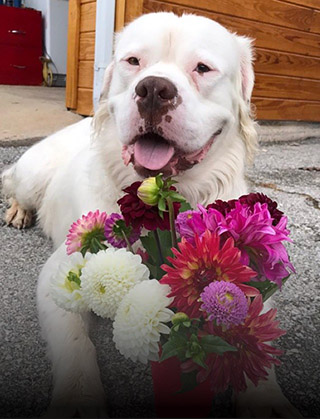Balanced Dog Training

Definition
Dog training which employs all training tools thoughtfully, not limited to treats. Balanced training uses both reward based and corrective techniques. It teaches the meaning of No, builds strong impulse control for all dogs, especially useful for anxious, reactive or aggressive dogs and provides rewards with touch, food, play and voice.
Benefits
- Use of the remote collar helps public safety because owners have a reliable tool to control their off leash dog around the public, livestock, wildlife and dogs.
- Correction teaches the dog the meaning of NO, which can ultimately save their life. For example- not running into the street, not chasing wildlife in remote areas, not injesting harmful substances on the ground
- The remote and prong collar enable disabled owners to have strong control safely in public where treats cannot provide this.
- Use of prong collar and/or E collar can be an alternative to euthanizing an aggressive or reactive dog that does not respond to treat training.
- Alternative training for dogs that are not treat motivated
- Empowers owners with tools that give them control in high distraction environments, where treats cannot.
- Remote collar trainng dogs freedom to be off leash
Testimonials
“Here’s the Luca story... adopted as a shy, seemingly mellow 4 month pup. So smart & so easy to train. Could take him in the car, to others’ houses, dog parks small & vast. Gave him lots of socialization, exercise & love, & everyone said he was the perfect gentleman. A petfood express trainer said he’d b a good candidate for canine citizenship! Starting around 1.5 yrs, though, he b came fear aggressive, nipping at people’s legs like a silent snake in waiting, no growl warning. I consulted with 4 different trainers who basically said what I was doing was fine. He just kept getting worse. Finally, Kathy came in & taught me to Get him to trust me to control the scene so he wouldn’t have to. With balanced training, we worked on trusting my down stay command even in the midst of activity. The prong & e-collar have helped enormously, esp around resource guarding. Luca today is a changed dog. Rather than being a nervous Nellie, he’s more relaxed and open.”
~Roku Kawaii
“I own a drafting breed. Hundreds of years of selective breeding for working on a farm have programed him to think a harness means it’s time for him to pull. I tried my darndest to work against this. I rewarded heel position, refused to move if he was pulling, turned in the other direction when he hit the end of the lead... I tried many of the techniques for teaching a dog to loose leash walk on a front pull harness but to no avail. Next, I conditioned him to a head halter. I got him to where he’d stick his nose in, ready to walk, and it would work for most of the walk until he’d see something he wanted. Then, my Abe would stick a nail under the nose loop and pull it off so he could do as he pleased. Neither of these tools could keep the pair of us safe on our walks, let alone keeping us having a nice time, building our bond and enjoying exercise together. And as someone with a history of joint dislocation, I cannot have a giant breed drafting dog who pulls.
Balanced training methods have repaired my relationship with my dog. I can safely walk him and am no longer scared that I won’t be able to keep him because of our repeated failures training with purely positive methods. He is a good dog and we love working together as a team but we needed to find a way to communicate which matched his drives and was safe for me as a petite woman with a chronic joint condition. Balanced training is exactly what we needed.”
~Hannah White
“Positive reinforcement only as a training technique simply does not work. Pet owners have the right and responsibility to train their dogs as they see best, which includes a balanced approach of positive reinforcement combined with correction.
I’ve had many dogs, and have used the positive reinforcement only technique with minimum success. However, I recently adopted a dog from a municipal shelter who had all sorts of social issues. She was very aggressive toward other dogs and would “go over the top” and be almost impossible to control, and positive reinforcement alone absolutely did not work for her.
I enrolled her in a balanced training program that used both positive reinforcement and correction. Through positive reinforcement she was taught how to behave appropriately. If she did not behave appropriately she would be given a correction which would be given by a verbal command and a physical correction.
If it weren’t for my ability to choose how to train my dog, and if the proper tools (prong collar, electric collar) weren’t available, I would not have been able to keep my dog, and the chances of her finding anyone who would take her would be low to non-existent.
My dog has been with me three years. She is now well adjusted and a pleasure to be with.”
~Hannah White
“My husband and I adopted Benny, a Labrador/Ridgeback mix, in August of 2010 and thought we had found the perfect dog. He was gentle with our cat, very mild mannered, and got along well with people and dogs. Six months later, nearly all of those things were still true -- everything except the getting along with dogs part. With increasing frequency, Benny started to show anxiety and aggression around other dogs.
We started working with Kathy in June 2011 and were immediately impressed with her knowledge of how to rehabilitate dogs. We came to her believing firmly in "positive only" training and had hesitations about correcting Benny using physical methods. Kathy was patient and supportive; she listened to our concerns with an open mind. She was clear that we should not do anything with Benny that made us uncomfortable, but also clear that her methods involve a mix of rewards and corrections. In giving it some serious thought we realized two things: (1) dogs use corrections to teach each other, and (2) positive only trainers often tell people who have aggressive dogs to stay away from other dogs, whereas Kathy was going to teach us how to help Benny break through the anxiety that causes the aggression. So we took a leap of faith, trusting the results we saw with Kathy's own rehabilitated dogs as well as the great reviews of her work that we read on Yelp and heard when doing reference checks.
Kathy trained us on a balanced training approach that entailed positive reinforcement, as well as verbal and physical corrections with a prong collar and an electronic collar. She taught us that Benny's aggression stemmed from anxiety and showed us ways to help him feel more secure, both at home and out in the world.
Something important to note: Kathy's training program is not a quick fix. She gives her clients a lot of attention, information, and support, but you will need to do the work with your dog. There is no silver bullet -- it takes commitment, time, and energy to see results. It's not easy and it's not always fun, but it is very, very rewarding and will create a bond with your dog like no other.”
~Ilana Golin
“My dog Arvo has terrible dog anxiety. He copes with this fear by being tough and aggressive toward other dogs. Outside of the dog realm, Arvo is a model pet: gentle with humans, loves people, incredibly bright, very obedient, craves human interaction. Positive feedback training has worked very well in that part of his life, but not at all with dog interactions.
When it came to dog interactions, he would be trapped in what I equate to a PTSD episode. There was no amount of praise or high value treats that would break through his singularly focused aggressive intent toward that other dog. He could not care one bit about listening to you or eating your cheese treat. This beautiful, wonderful dog in the human word, was a frightened, desperate bully in the dog world.
Kathy's balance training changed that. By the end of our training course, I could get through to Arvo in these situations. Because during all of our training time together, a very quick e-collar correction was the one thing that would snap him out of his aggressive thrall and return his focus to me. And it was at that moment that I could use praise, and my voice, and clear body language and leash control to guide him through the situation.
The key takeaway here, is that there was one thing that would interrupt my dog's singular mindset to do harm to another dog. It was an e-collar correction. Now, after all of that training, it's my voice.
Arvo looks to me now for guidance when he's stressed, and I help him through those situations. He's a different dog. So much so that later today we'll go to the dog park where he will run off-leash happily and sniff some dog butts, no problem.
I am forever grateful for Kathy and her balance training.”
~Casey Cameron
“We got our dog Copper from Golden Gate lab rescue. The day after we brought him home he tried to attack our neighbors dog. Within the first month that we had him he bit two people. He was put in quarantine and has a record. If he were to bite one more person we would’ve had to put him down. Lab rescue offered to take him back but they were going to put him down right away. Our only hope for his survival was to drastically change his behavior in a relatively short period of time. We used private training along with the E-collar, prong collar, and muzzle. Without all these tools he would not be with us now, he would’ve been put down. Positive reinforcement alone just wasn’t an option. It wouldn’t have given the desired results quick enough to save his life.”
~Marc Kellond
